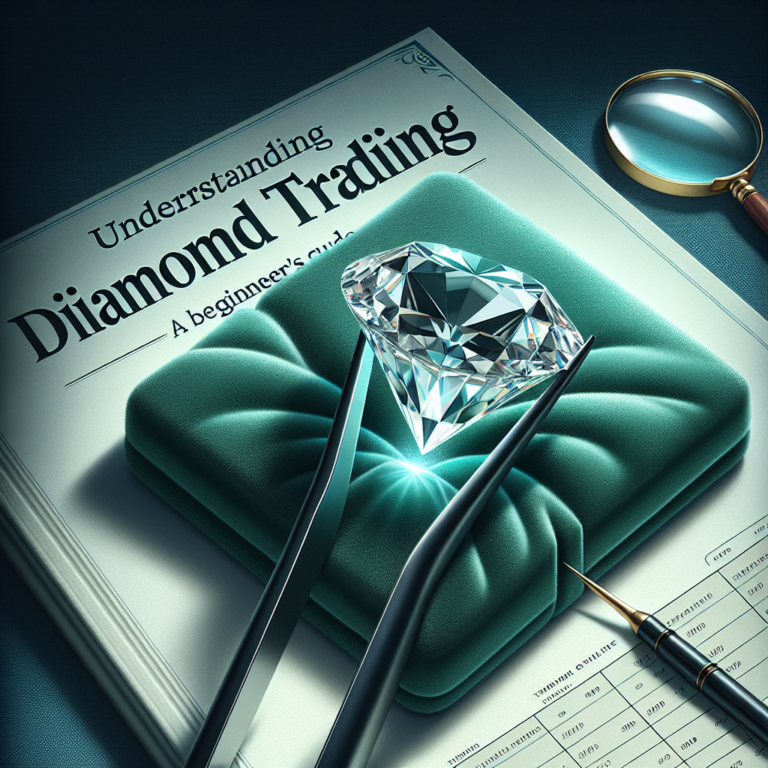Understanding Diamond Trading: A Beginner’s Guide
The world of diamond trading can seem both glamorous and complex. From understanding the 4Cs of diamonds to navigating market trends, there’s a wealth of information to consider for anyone looking to engage in this industry. This comprehensive beginner’s guide will provide you with valuable insights into diamond trading, helping you build a solid foundation as you embark on your journey in this vibrant marketplace.
What is Diamond Trading?
Diamond trading refers to the process of buying and selling diamonds, whether in wholesale markets or retail settings. This industry encompasses various facets, including sourcing diamonds, evaluating their quality, and pricing them appropriately.
The Importance of Quality in Diamond Trading
One of the key aspects of diamond trading is understanding the quality of diamonds. The 4Cs—Cut, Color, Clarity, and Carat weight—are critical factors that determine a diamond’s value. For instance, a well-cut diamond will reflect light beautifully, enhancing its brilliance and overall appearance.
- Cut: The quality of the diamond’s cut influences its sparkle and should not be overlooked.
- Color: Diamonds range from colorless to shades of yellow or brown; the less color, the higher the value.
- Clarity: This refers to the presence of inclusions or blemishes; a higher clarity rating means a more valuable diamond.
- Carat Weight: This measures the size of the diamond, with larger diamonds generally being more valuable.
Current Market Trends
Understanding current market conditions is essential for anyone engaging in diamond trading. As of 2023, the global diamond market is valued at approximately $80 billion, with projections suggesting a steady growth over the next few years. Interestingly, diamond prices have seen an increase of 5-10% annually, primarily due to rising demand in emerging markets and the popularity of lab-grown diamonds.
- Emerging Markets: Countries like India and China are rapidly increasing their consumer base for diamonds, significantly impacting prices.
- Lab-Grown Diamonds: There’s a notable shift toward ethical sourcing, with lab-grown diamonds gaining traction. As a result, traditional diamond prices may fluctuate in response to increased competition.
How to Get Started in Diamond Trading
Entering the world of diamond trading may seem daunting, but with the right approach and knowledge, you can thrive in this market.
Research and Educate Yourself
Before making any investments, it’s crucial to familiarize yourself with the industry. Here are a few key resources to help you get started:
- Books on Gemology: Understanding the science behind diamonds will give you an edge.
- Online Courses: Platforms like Coursera offer courses on gemology and diamond evaluation.
Build a Network
Networking with industry professionals can be invaluable. Attend trade shows, join online communities, and connect with local jewelers to gain insights and advice.
Consider Investment Risks
Like any trading market, diamond trading comes with its risks. Diamond prices can be volatile based on market trends, supply and demand dynamics, and customer preferences. It’s essential to do your due diligence and consider diversifying your portfolio to mitigate potential losses.
Pricing Diamonds: A Complex Equation
Pricing a diamond goes beyond just the 4Cs. Factors such as market conditions, brand reputation, and the diamond’s provenance significantly influence its value. For example, a diamond with a well-documented history or from a renowned mine may command a premium price.
Evaluating and Purchasing Diamonds
When evaluating diamonds, consider consulting with a certified gemologist who can provide an accurate appraisal. This is critical in ensuring you invest in diamonds that are worth their asking prices.
- Gemological Institute of America (GIA): Ensure your diamonds are certified by reputable organizations like GIA to validate their quality.
Focus on Ethical Practices
With increasing consumer awareness about ethical sourcing, it’s crucial to consider the origin of the diamonds you trade. Engaging in ethical sourcing not only enhances your brand reputation but also appeals to conscientious consumers.
Conclusion: Taking the Next Steps in Diamond Trading
Now that you understand the basics of diamond trading, it’s time to take the next steps to deepen your involvement in this captivating industry. Whether it’s attending workshops, subscribing to industry newsletters, or connecting with experienced traders, there are many avenues to explore.
Take Action Today!
For more in-depth information on diamond pricing, check out our other articles on TheDiamondPrice.com, such as “The 4Cs of Diamonds Explained” and “How to Choose the Right Diamond for You.”
Additionally, if you’re eager to stay updated on industry trends or have questions about diamonds, feel free to subscribe to our newsletter. Your journey in diamond trading is just beginning!
Suggested Images:
- Image 1: A close-up of a diamond with a beautiful cut. Alt Text: Diamond Trading – The Importance of Cut Quality
- Image 2: A diamond marketplace showcasing traders and customers. Alt Text: Diamond Trading – The Global Marketplace


